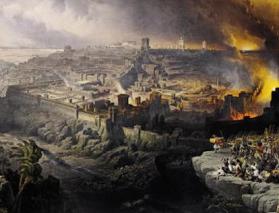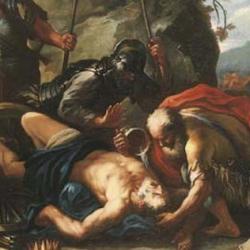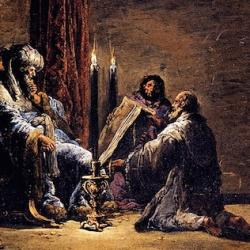David gives Solomon the “plan” (Heb. tabnit) for the temple. Unlike Moses, David doesn’t have to climb a mountain to get it (cf. Exodus 25:9, 40). It comes from “the spirit (ruach) with him” (1 Chronicles 28:12), and from a “writing” from the Lord that comes “by His hand upon me” (1 Chronicles 28:19). Apparently, we are to understand the ruach as Yahweh’s own who inspires David to produce a written plan (Mark Boda, 1-2 Chronicles).
David’s tabnit comes from Yahweh as much as Moses’, but David is a more active agent. He doesn’t simply see a pattern and replicate it; the pattern comes from within him and he writes it, though only because Yahweh’s hand is on him.
David is a step forward in the progress of human creativity: The first creation was by Yahweh’s unmediated word; the second creation of the tabernacle came through Moses’ conformity to the tabnit he saw on the mountain; the tabnit for the new creation of the temple is imprinted in David’s heart, written, then passed to Solomon. Yahweh’s Spirit hovered over creation to give it form and fullness; Yahweh’s Spirit hovers over David so he can form and fill a new world.
Another shift is implied as well: Moses saw a portrayal of the tabernacle (a model, or the true heavenly sanctuary); David’s plan comes by writing or is expressed in writing. With David, the tabnit becomes verbalized.
Moses is a “classicist” who builds by imitating a model; David is more a “romantic” who formulates a plan by expressing what the Spirit places on his heart. Yet David isn’t exactly romantic. His “self-expression” is actually an expression of what the hand of Yahweh laid on him. Besides, it appears that David comes to understand the pattern by writing it. Writing is a coming-to-know, not merely an expression of something already known. That isn’t either classicist or romantic, but Baroque. In the new covenant, we are all “romantics” and “Baroque” creators, indwelt by the Spirit who implants the pattern of God’s temple in our hearts and writes it in the Scriptures so, equipped by the Spirit, we can build in step with the Spirit’s plan.
Tabnit is used four times in 1 Chronicles 28 (vv. 11-12, 18-19), the only uses in Chronicles. In the Hebrew Bible, the word has an intriguingly complex usage. It is used twice in Exodus to describe a model or blueprint for the tabernacle (Exodus 25:9, 40). Deuteronomy 4:16-18 uses the word five times, not of a “model” or “plan” but of likenesses made according to a plan or model. Yahweh prohibits Israel from making and venerating a tabnit of male or female, animals, birds, creeping things, or fish (note the Genesis 1 classification of creatures). Here the living creature – the woman or the calf or the snake – is the model, and the graven-thing is the likeness of the model. The word tabnit is used for the copy rather than the original (cf. the similar use in Psalm 106:20; Isaiah 44:13; Ezekiel 8:10).
Derived from banah, “build,” tabnit can embrace the whole process of building or making. It names the initial conception, the plan or model, and the finished object, a copy of the model or execution of the plan. It is both exemplar and instance, model and product, an ideal thing-to-be-built and the particular, concrete built-thing (usually an idol). It’s significant that both the ideal and object are designated as tabnit.
We might infer this: For the Old Testament, a conception is as much as a construct as the construction. Conceiving a plan is as much a making or building as the physical making or building. And, once again, we can perhaps surmise an interaction between the two: The ideal construct or plan takes form, or at least polished form, in the execution of the plan. We don’t conceive and then build; we build a conception that matures as we build the thing conceived.
It’s doubtless significant that the tabernacle and temple are never described as tabnit. They could be, since they are likenesses of Yahweh’s glory. But only false likenesses, idols, are described as tabnit. The tabernacle and temple are rightly built because they are built according to the “made thing” that Moses saw on the mountain, the made thing that David received in his heart by the Spirit.











